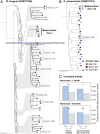This is a preprint.
Assembly, stability, and dynamics of the infant gut microbiome are linked to bacterial strains and functions in mother's milk
- PMID: 38328166
- PMCID: PMC10849666
- DOI: 10.1101/2024.01.28.577594
Assembly, stability, and dynamics of the infant gut microbiome are linked to bacterial strains and functions in mother's milk
Abstract
The establishment of the gut microbiome in early life is critical for healthy infant development. Although human milk is recommended as the sole source of nutrition for the human infant, little is known about how variation in milk composition, and especially the milk microbiome, shapes the microbial communities in the infant gut. Here, we quantified the similarity between the maternal milk and the infant gut microbiome using 507 metagenomic samples collected from 195 mother-infant pairs at one, three, and six months postpartum. We found that the microbial taxonomic overlap between milk and the infant gut was driven by bifidobacteria, in particular by B. longum. Infant stool samples dominated by B. longum also showed higher temporal stability compared to samples dominated by other species. We identified two instances of strain sharing between maternal milk and the infant gut, one involving a commensal (B. longum) and one a pathobiont (K. pneumoniae). In addition, strain sharing between unrelated infants was higher among infants born at the same hospital compared to infants born in different hospitals, suggesting a potential role of the hospital environment in shaping the infant gut microbiome composition. The infant gut microbiome at one month compared to six months of age was enriched in metabolic pathways associated with de-novo molecule biosynthesis, suggesting that early colonisers might be more versatile and metabolically independent compared to later colonizers. Lastly, we found a significant overlap in antimicrobial resistance genes carriage between the mother's milk and their infant's gut microbiome. Taken together, our results suggest that the human milk microbiome has an important role in the assembly, composition, and stability of the infant gut microbiome.
Figures





References
Publication types
Grants and funding
LinkOut - more resources
Full Text Sources
